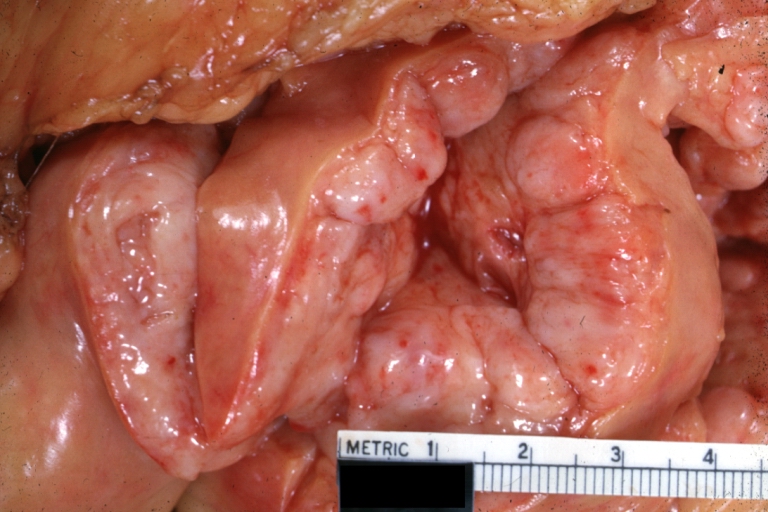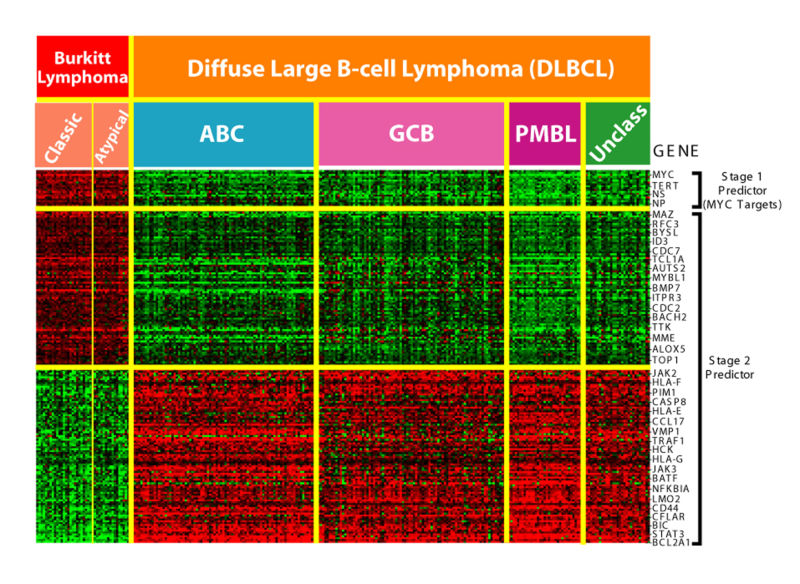Lymphoma: Difference between revisions
| Line 68: | Line 68: | ||
**[[T-cell large granular lymphocyte leukemia|T cell large granular lymphocytic leukemia]] | **[[T-cell large granular lymphocyte leukemia|T cell large granular lymphocytic leukemia]] | ||
**Aggressive NK cell leukemia | **Aggressive NK cell leukemia | ||
**[[Adult T cell leukemia|Adult T cell leukemia/lymphoma (ATLL)]] | **[[Adult T-cell leukemia|Adult T-cell leukemia/lymphoma (ATLL)]] | ||
**Extranodal NK/T cell lymphoma, nasal type | **Extranodal NK/T cell lymphoma, nasal type | ||
**Enteropathy-type T cell lymphoma | **Enteropathy-type T cell lymphoma | ||
Revision as of 08:52, 27 February 2010
For patient information click here
| Lymphoma | |
 | |
|---|---|
| Lymph node: Malignant Lymphoma Large Cell Type: Gross natural color excellent view of cut mesentery showing massively enlarged mesenteric nodes with focal hemorrhages case diagnosed several years ago as reticulum cell sarcoma excellent demonstration of nodes with lymphoma. Image courtesy of Professor Peter Anderson DVM PhD and published with permission © PEIR, University of Alabama at Birmingham, Department of Pathology | |
| ICD-10 | C81-C96 |
| ICD-O: | 9590-9999 |
| MeSH | D008223 |
|
WikiDoc Resources for Lymphoma |
|
Articles |
|---|
|
Most recent articles on Lymphoma |
|
Media |
|
Evidence Based Medicine |
|
Clinical Trials |
|
Ongoing Trials on Lymphoma at Clinical Trials.gov Clinical Trials on Lymphoma at Google
|
|
Guidelines / Policies / Govt |
|
US National Guidelines Clearinghouse on Lymphoma
|
|
Books |
|
News |
|
Commentary |
|
Definitions |
|
Patient Resources / Community |
|
Directions to Hospitals Treating Lymphoma Risk calculators and risk factors for Lymphoma
|
|
Healthcare Provider Resources |
|
Causes & Risk Factors for Lymphoma |
|
Continuing Medical Education (CME) |
|
International |
|
|
|
Business |
|
Experimental / Informatics |
Editor-In-Chief: C. Michael Gibson, M.S., M.D. [1] Associate Editor-in-Chief: Ross Bonander
Please Take Over This Page and Apply to be Editor-In-Chief for this topic: There can be one or more than one Editor-In-Chief. You may also apply to be an Associate Editor-In-Chief of one of the subtopics below. Please mail us [2] to indicate your interest in serving either as an Editor-In-Chief of the entire topic or as an Associate Editor-In-Chief for a subtopic. Please be sure to attach your CV and or biographical sketch.
Overview
Lymphoma is a type of cancer that originates in lymphocytes (a type of white blood cell in the vertebrate immune system). There are many types of lymphoma. Lymphomas are part of the broad group of diseases called hematological neoplasms.
In the 19th and 20th centuries the affliction was called Hodgkin's Disease, as it was discovered by Thomas Hodgkin in 1832. Colloquially, lymphoma is broadly categorized as Hodgkin's lymphoma and non-Hodgkin lymphoma (all other types of lymphoma). Scientific classification of the types of lymphoma is more detailed.
Although older classifications referred to histiocytic lymphomas, these are recognized in newer classifications as of B, T or NK cell lineage. Histiocytic malignancies are rare and are classified as sarcomas.[1]
Prevalence
According to the U.S. National Institutes of Health, lymphomas account for about five percent of all cases of cancer in the United States, and Hodgkin's lymphoma in particular accounts for less than one percent of all cases of cancer in the United States.
Because the lymphatic system is part of the body's immune system, patients with a weakened immune system, such as from HIV infection or from certain drugs or medication, also have a higher incidence of lymphoma.
Classification
WHO classification
The WHO Classification is the latest classification of lymphoma, published by the World Health Organization in 2001.[1] It was based upon the "Revised European-American Lymphoma classification" (REAL).
This classification attempts to classify lymphomas by cell type, i.e. the normal cell type that most closely resembles the tumor. They are classified in three large groups: the B cell tumors, the T cell and natural killer cell tumors, Hodgkin lymphoma, and other minor groups: (ICD-O codes are provided where available)
Mature B cell neoplasms
- Chronic lymphocytic leukemia/small lymphocytic lymphoma
- B-cell prolymphocytic leukemia
- Lymphoplasmacytic lymphoma/Waldenström macroglobulinemia
- Splenic marginal zone lymphoma
- Plasma cell neoplasms
- Plasma cell myeloma
- Plasmacytoma
- Monoclonal immunoglobulin deposition diseases
- Heavy chain diseases
- Extranodal marginal zone B cell lymphoma (MALT lymphoma)
- Nodal marginal zone B cell lymphoma
- Follicular lymphoma
- Mantle cell lymphoma
- Diffuse large B cell lymphoma
- Mediastinal (thymic) large B cell lymphoma
- Intravascular large B cell lymphoma
- Primary effusion lymphoma
- Burkitt's lymphoma
- Lymphomatoid granulomatosis

Mature T cell and natural killer (NK) cell neoplasms
- T cell prolymphocytic leukemia
- T cell large granular lymphocytic leukemia
- Aggressive NK cell leukemia
- Adult T-cell leukemia/lymphoma (ATLL)
- Extranodal NK/T cell lymphoma, nasal type
- Enteropathy-type T cell lymphoma
- Hepatosplenic T cell lymphoma
- Blastic NK cell lymphoma
- Mycosis fungoides / Sezary syndrome
- Primary cutaneous CD30-positive T cell lymphoproliferative disorders
- Primary cutaneous anaplastic large cell lymphoma
- Lymphomatoid papulosis
- Angioimmunoblastic T cell lymphoma
- Peripheral T cell lymphoma, unspecified
- Anaplastic large cell lymphoma
Hodgkin Lymphoma
- Nodular lymphocyte-predominant Hodgkin lymphoma
- Classical Hodgkin lymphoma
- Nodular sclerosis
- Mixed cellularity
- Lymphocyte-rich
- Lymphocyte depleted or not depleted
Immunodeficiency-associated lymphoproliferative disorders
- Associated with a primary immune disorder
- Associated with the Human Immunodeficiency Virus (HIV)
- Post-transplant
- Associated with Methotrexate therapy
Working formulation
The Working Formulation, published in 1982, is primarily descriptive. It is still occasionally used, but has been superseded by the WHO classification, above.
Low grade
- Malignant Lymphoma, small lymphocytic (chronic lymphocytic leukemia)
- Malignant Lymphoma, follicular, predominantly small cleaved cell
- Malignant Lymphoma, follicular, mixed (small cleaved and large cell)
High grade
- Malignant Lymphoma, large cell, immunoblastic
- Malignant Lymphoma, lymphoblastic
- Malignant Lymphoma, small non-cleaved cells (Burkitt's lymphoma)
Miscellaneous
- Composite
- Mycosis fungoides
- Histiocytic
- Extramedullary plasmacytoma
- Unclassifiable
Other classification systems
For diagnosis, etiology, staging, prognosis, and treatment
Please see separate links to Hodgkin's lymphoma and non-Hodgkin's lymphoma.
Genetics
Enteropathy associated T-cell lymphoma (EATL) is environmentally induced as a result of the consumption of Triticeae glutens. In gluten sensitive individuals with EATL 68% are homozygotes of the DQB1*02 subtype at the HLA-DQB1 locus (serotype DQ2).[2] (See Coeliac Disease, HLA-DQ, HLA DR3-DQ2)
See also
- Hodgkin's lymphoma
- Non-Hodgkin's lymphoma
- Follicular lymphoma
- Burkitt's lymphoma
- Mantle cell lymphoma
- Gastric lymphoma
- Cutaneous T Cell lymphoma
- Mycosis fungoides
- Anaplastic large cell lymphoma
- MALT lymphoma
- Primary central nervous system lymphoma
- BCP-1 cells
- Ann Arbor staging
- International Prognostic Index
References
- ↑ 1.0 1.1 Pathology and Genetics of Haemo (World Health Organization Classification of Tumours S.). Oxford Univ Pr. ISBN 92-832-2411-6.
- ↑ Al-Toma A, Verbeek WH, Hadithi M, von Blomberg BM, Mulder CJ (2007). "Survival in Refractory Coeliac Disease and Enteropathy associated T cell Lymphoma: Retrospective evaluation of single centre experience". doi:10.1136/gut.2006.114512. PMID 17470479.
External links
Research Foundations
Information
- MedlinePlus: Lymphoma
- ICD10 classification of lymphoma
- About Lymphoma: A guide to lymphoma for patients
- "Pathology and Genetics of Tumours of Haemopoietic and Lymphoid Tissues"
- Lymphomas in Children and Adolescents The Centre for Cancer and Blood Disorders at Sydney Children’s Hospital provides information on cancers in children and adolescents, including Hodgkins Disease and Non-Hodgkins lymphomas.
- Summary at NIH/National Cancer Institute
- Non-Hodgkin's Lymphoma Symptoms & Support Information
Societies and Support Groups
- The Leukemia & Lymphoma Society
- The Lymphoma Association (UK)
- A Lot of Life! Positive Stories from a Survivor at Large
- Lymphoma Support Groups
- Lymphoma Support Ireland - Booklets & Patient Stories online
- Support Group web site for the Coventry Lymphoma Association Support Group in the UK
Statistics
- US Lymphoma SEER Fact Sheet from the National Cancer Institute
- UK Hodgkin Lymphoma Statistics
- UK Non-Hodgkin Lymphoma Statistics
- About Lymphomas - Patients Against Lymphoma
- Timeline of discovery and treatment of Hodgkin's Lymphoma
- National Cancer Institute (May 2007). "Risk of Lymphoma Increases with Hepatitis C Virus Infection".
Template:SIB bg:Лимфома ar:سرطان الغدد الليمفاوية de:Malignes Lymphom eu:Linfoma ia:Lymphoma it:Linfoma he:לימפומה lt:Limfoma nl:Maligne lymfoom no:Lymfekreft fi:Lymfooma